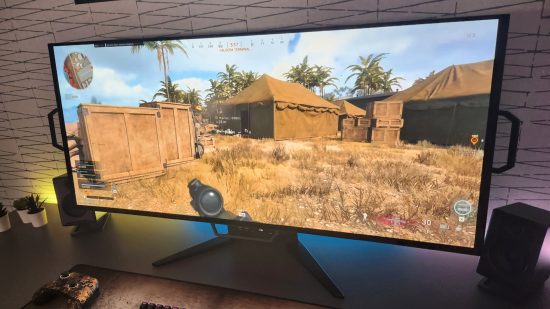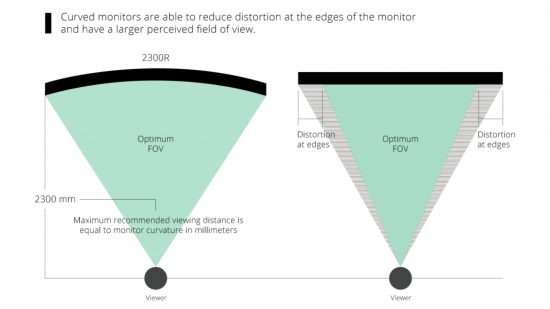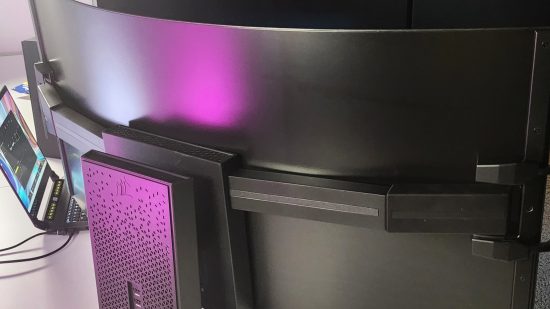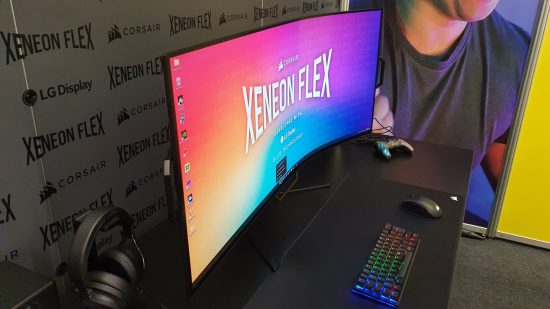Corsair recently celebrated a new milestone in foldable technology by announcing the world’s first gaming monitor that can be adjusted to your liking. This is all thanks to LG’s new panel that will also grace upcoming gaming TVs, but it makes you wonder… why? Being able to fold the monitor to your liking is an impressive feat, and you’re sure to be the envy of your friends until the wow factor wears off, but does this feature offer an advantage over static alternatives?
As its name suggests, the Corsair Xeneon Flex 45WQHD240 is equally equipped with the best monitor for gaming. It is a 45-inch 1440p ultrawide gaming monitor with a 240Hz refresh rate. It also has a 0.03ms response time, 1000nits of brightness and is the brand’s first OLED panel. I find it much brighter than the Corsair Xeneon 32UHD144, but with OLED gaming monitors slamming left, right, and center, the real star is its flexability.
How does it work
To fold the monitor, you need to grab the retractable handles on both sides of the screen and push them together. Since we have a prototype model in our hands, it is possible that things will change before it reaches the market, but the process is still not going well.
The screen is quite rigid, which means you walk a fine line between manually manipulating the monitor to flatten it or bending it without putting pressure on the screen. Corsair assures us that the screen is solid, but like my first experience with the Samsung Galaxy Z Flip 4, it will be a while before my stomach stops sinking and tilting becomes second nature.
There are no prerequisites for folding, which means you don’t need to turn off the power before you start folding. Corsair includes a crackle-like click that lets you know when you’ve reached the limit of the 800R curve, which may add to your fear of breaking it, but serves the opposite purpose. You’ll probably want to take off your gaming headset to do this, as they’re not touch-sensitive and the audio is easily drowned out by conversations.

For whom it is?
Stefan Quiring, Associate PR at Corsair Europe, tells us that Flex is a “special use case” where you can immerse yourself in UI elements while cornering, much like playing in Forza Horizon 5 on cabin mode, or choose flat. screen when working. The reason for this is that “it’s easier to follow a line of text on a flat screen” without the distortion or shadows that a curved screen brings, or so we’re told.
Well, I regularly rapproche the monitor to compensate for eye fatigue lorsque je joue à Rainbow Six Siege, je n’ai jamais eu envie de changer mon écran de plat à incurvé or vice versa – et je travaille régulièrement à des miême PC de jeu that I. . play. Even after stepping into the shoes of the Master Chief in Halo Infinite, I still feel like the Corsair Xeneon Flex answers a question no one really asked, but there’s science behind it.
By adapting to the shape of your eyes, curved monitors provide greater immersion with a better perceived field of view by reducing edge distortion common to flat screens. When we use the term “distorted” here, it’s not about the quality of the image the monitor creates around the outer edges of the screen, but rather how your peripheral vision sees the image when focused on the center of the screen.

Image credit: ViewSonic
You’re less stressed when interpreting peripheral images, which means less fatigue and more comfort while gaming. This is especially true for FPS games, as it makes your peripheral vision more reliable so you can focus on the central crosshair instead of scanning the screen for an enemy.
Curved screens have few disadvantages. They don’t work as well with on-screen text as flat options because the font can become distorted and make your eyes more strained when reading. They’re also more difficult to place on a gaming table to prevent glare from windows and RGB lighting in your room, since the surface faces several different directions at once.

Should you buy a Corsair Flex?
The value of the Corsair Xeneon Flex is directly related to its price, which we don’t know yet. Corsair has already cut costs by making this process manual rather than motorized, as well as avoiding potentially unnecessary points of failure, but the new feature is likely to come at an additional cost. However, regardless of the cost, it comes with some trade-offs that you might not like.
The first is the lack of mounting options, as Flex technology limits you to the included mount. Thankfully, this stand includes a sleek hub of ports more accessible than the ones behind the screen, and Corsair is working on a proprietary solution that will let you clamp the monitor to a table, but that could be a deal breaker if you don’t. . t. . like two legs sticking out and going into the mouse pad.

You’ll also have a hard time fitting the Flex into a multi-monitor setup because you don’t want anything to get in the way of the buttons that let you bend the curve. You can stack them higher and you may not even see the need for a second screen given its 45-inches, but that comes down to personal preference.
If you can get over these hurdles, give credit where it counts, because no gaming monitor fits the bill for the Corsair Xeneon Flex 45WQHD240. It’s bright, fast, smooth and unique. However, competition from LG UltraGear, Asus ROG and Samsung Odyssey is intensifying. It’s all based on the final suggested retail price, and the $1,499.99 price tag for the entry-level LG UltraGear 48GQ900 doesn’t give us any guarantees that it’s affordable for everyone but professionals.
Source : PC Gamesn

